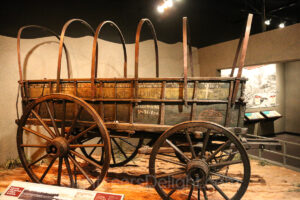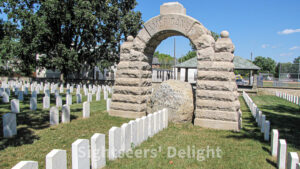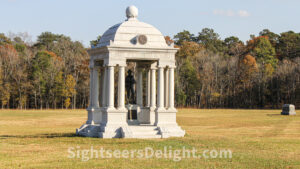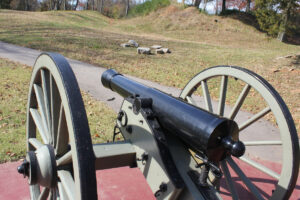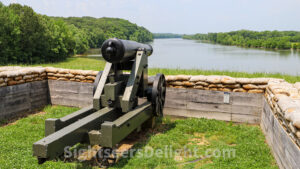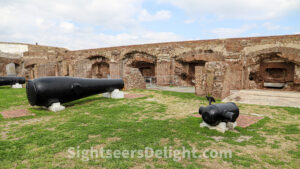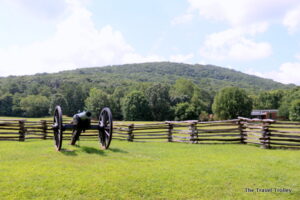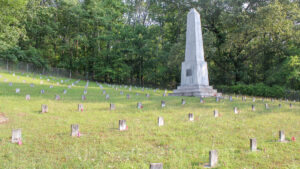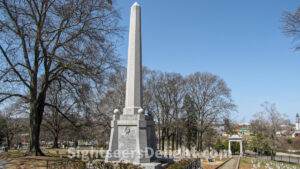After Atlanta fell, Confederate Gen. John Bell Hood began marching toward Nashville, Tenn., hoping to break Sherman’s supply line. Hood attacked at Union troops positioned at a railroad pass southeast of Cartersville. The Battle of Allatoona Pass on Oct. 5, 1864, is among the Civil War’s bloodiest battles, and roughly 1,600 soldiers on both sides died. The railroad has been rerouted, but the battle site now sits on the edge of Lake Allatoona and is part of Red Top Mountain State Park.
30120
Located in the heart of Atlanta’s trendy Buckhead community, the Atlanta History Center was founded in 1926. The museum, which sits on a 33-acre campus, features six permanent exhibits and temporary exhibits. In addition to the main exhibits, the museum is also home to the historic Swan House, Tullie Smith Farm and Wood Family Cabin. The museum is home to one of the largest collections of Civil War artifacts in the United States.
30305
During the Civil War, Camp Chase, named for Salmon P. Chase, the Secretary of the Treasury under President Abraham Lincoln and a former governor of Ohio, was home to a military training camp for Union troops and one of the largest Confederate prisons. The first occupants of Camp Chase’s prison were political prisoners, but during the Civil War, as many as 25,000 Confederate soldiers passed through the camp, which was built to house 3,500-4,000 prisoners. By the end of January 1865, the prison held more than 9,400 prisoners. Today, the only remnant of the camp are the graves of 2,260 Confederate soldiers, buried in quarters so tight their headstones nearly touch one another. In the middle stands a monument — with the word “Americans” engraved into its “memorial arch.”
Chickamauga and Chattanooga National Military Park preserves the sites of two major battles of the American Civil War: the Battle of Chickamauga and the Chattanooga Campaign.
30742
Confederate troops in November 1861 built defenses overlooking the Cumberland and Red rivers. Following a major battle at Fort Donelson in nearby Dover, Confederate troops abandoned Clarksville; Union troops later found the abandoned fort and reworked it for their needs. In 2011, the city opened a $2 million interpretive center to tell the story of Fort Defiance. In addition to a movie in the center, visitors can see remarkable well preserved earthworks at the site and take in a newly installed Confederate money exhibit.
37042
Fort Donelson National Battlefield preserves the resources of and tells the stories of the 1862 campaign and battles for Forts Henry, Heiman, and Donelson, and the opening of the Tennessee and Cumberland Rivers. The national park includes Fort Donelson National Cemetery, established in 1867, as the final resting for Union soldiers and sailors initially buried in the Fort Donelson area. It contains the remains of 670 Civil War burials and roughly 909 veterans from other wars. Dover Hotel, the Surrender House, was built between 1851 and 1853 and served riverboat travelers before and after the Civil War. Confederate Brig. General Simon B. Buckner and his staff used the hotel as their headquarters during the battle. Buckner surrendered to Union Gen. Ulysses S. Grant in the hotel.
37058
Fort Sumter is a sea fort built on an artificial island near Charleston, South Carolina to defend the region from a naval invasion. It was built after British forces captured and occupied Washington during the War of 1812 via a naval attack.
29412
Kennesaw Mountain National Battlefield Park offers the opportunity to connect with an important time in American history and a free outdoor experience. Located between Marietta and Kennesaw, the 2,923-acre national park offers visitors the chance to learn about an important time in history and also enjoy the great outdoors. The national park features 18 miles of walking trails, some rather steep as they approach the top of the mountain. The park features three battlefield areas: one located in front of the Visitor Center, another off Burnt Hickory Road and the main site at Cheatham Hill, which during the Civil War was called the Dead Angle. The visitor center is a logical place to start because it provides an abundance of information about what happened during the battle.
The cemetery is home to the oldest running Confederate Memorial Day celebration, also known as “Decoration Day.” The celebration started in 1865.
As the Civil War dragged on, wounded soldiers from the battles that ravaged North Georgia were taken to Marietta to be buried. That continued until Gen. William T. Sherman took control of the city on July 2, 1864. Following the war, Henry Greene Cole, a Marietta businessman and Unionist, offered land to build a cemetery for both Union and Confederate soldiers, but many city residents wouldn’t entertain the proposal of burying battlefield enemies in the same graveyard. So, in 1867, Jane Glover officially gave the land to a memorial association to create the cemetery for Confederate soldiers. Union troops who were killed throughout North Georgia were re-buried in the nearby Marietta National Cemetery. In addition to the more than 3,000 grave sites, the cemetery is home to a number of monuments, including a six-pound cannon that Union troops captured near Savannah. The cannon resided at the Georgia Military Institute for a number of years.
30064


